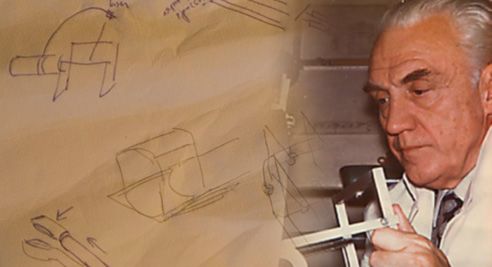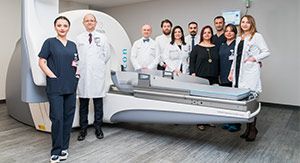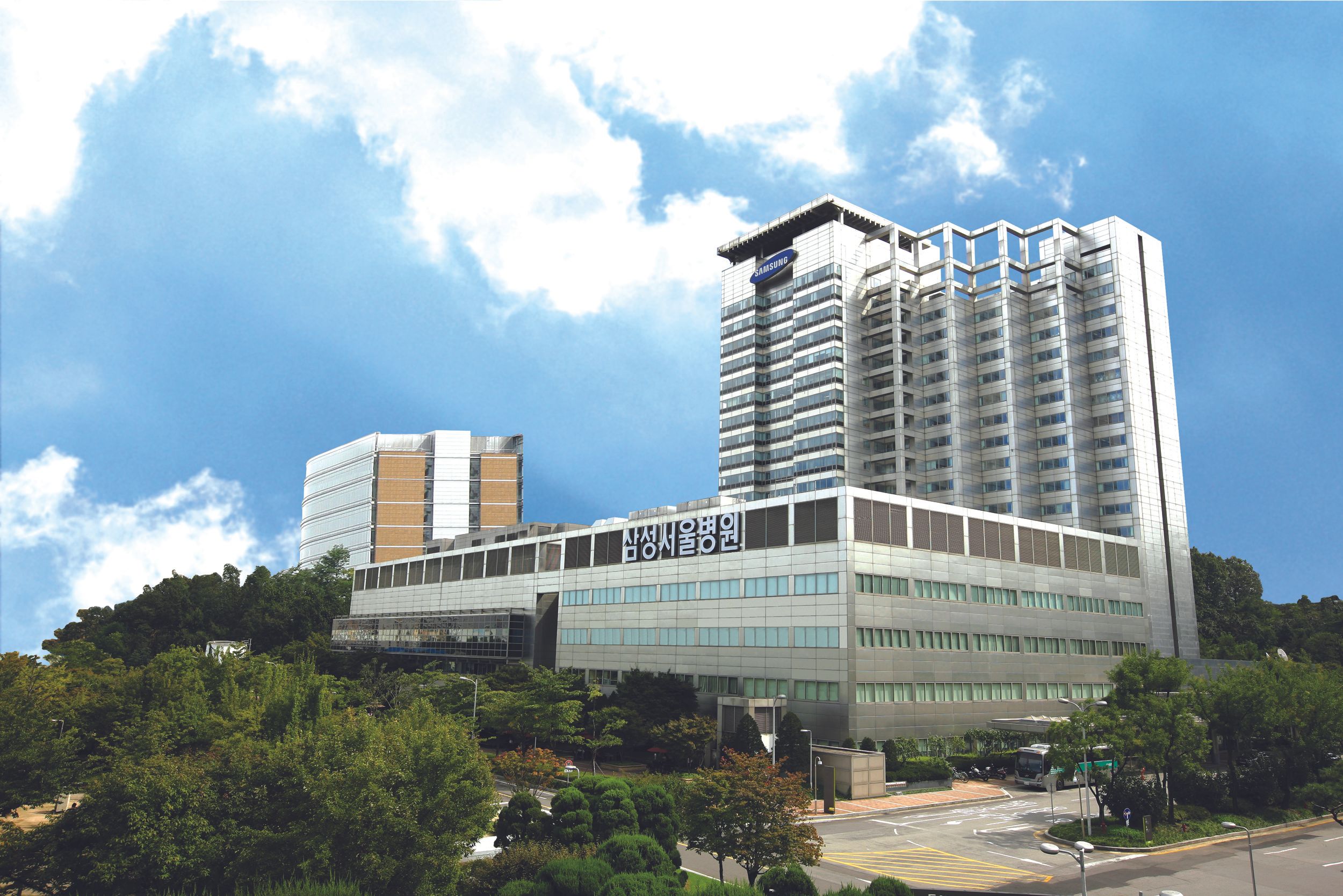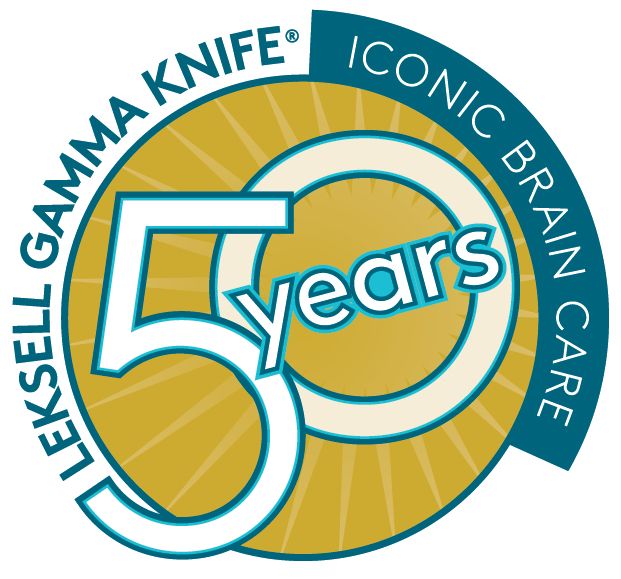Roswell Park’s 20 Year Milestone with Gamma Knife Radiosurgery
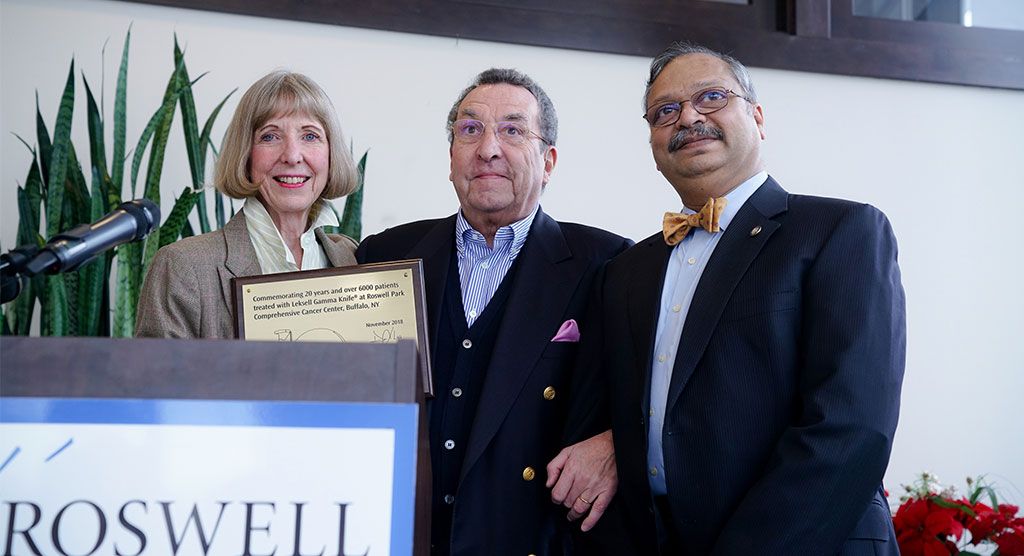
Dan Leksell, MD, talks with Leksell Gamma Knife radiosurgery veteran, Dr. Dheerendra Prasad
Dan Leksell, MD, son of Prof. Lars Leksell – creator of Elekta’s Leksell Gamma Knife® – sat down recently with his friend and colleague, Dheerendra Prasad, MD. Dr. Leksell and Dr. Prasad, a renowned Gamma Knife radiosurgery veteran, discussed their friendship and shared passion for the intracranial treatment technology that has changed almost 1.2 million lives since 1991.
At Roswell Park Comprehensive Cancer Center (Buffalo, New York, USA), Dr. Prasad serves as Director of the Gamma Knife Center, Medical Director of Radiation Medicine, and Director of Central Nervous System & Pediatric Radiation Medicine.
Dan Leksell: What are your recollections about how we first met?
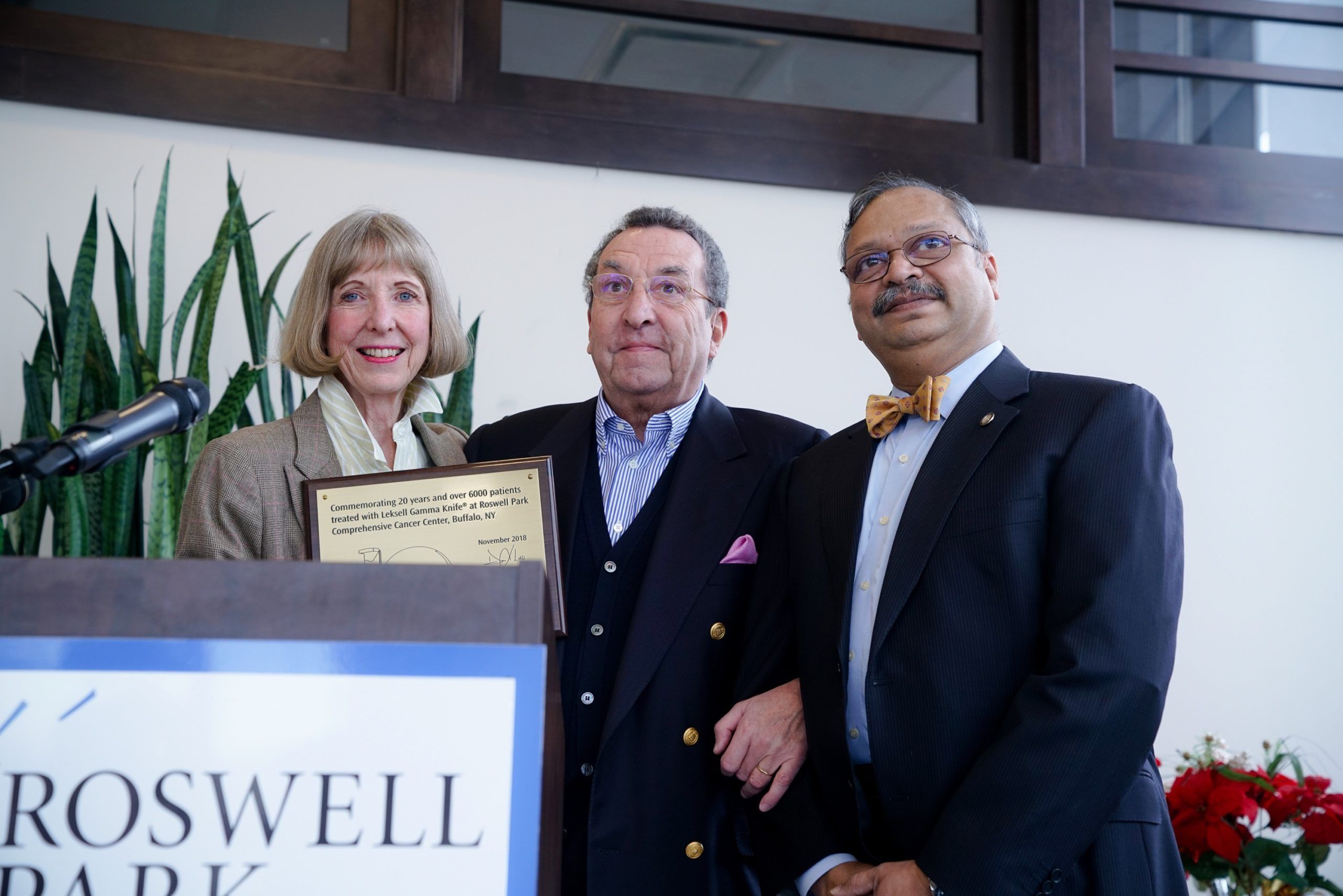
Dheerendra Prasad: It was 1994 at the University of Virginia (UVA) at Charlottesville, at one of the Leksell lecture events with Dr. Ladislau Steiner. You’ll recall that Dr. Steiner always liked to have a classical music interlude between lectures, and we met the first time there when he introduced me to you.
I was Dr. Steiner’s Lars Leksell Fellow in Radiosurgery at the University of Virginia. He described to me in great detail how he used to see you and your brother Larry running about the Leksell home when he would visit with your father. You and I have met fairly regularly since 1994 at all the Leksell Gamma Knife® Society meetings and other academic conferences. Over time, we have discussed Gamma Knife radiosurgery, Gamma Knife programs, the evolution of the technology, and the challenges the treatment platform has faced in its acceptance and evolution over the years.
Leksell: You’ve been using Gamma Knife technology for quite some time. Can you review your early experiences with Leksell Gamma Knife, the first indications you treated and your initial impressions of the technology and treatment?
Prasad: I had heard and read a lot about Gamma Knife surgery before I came to the U.S. from India. In fact, the main reason I emigrated to America was to train on Gamma Knife technology as Dr. Steiner’s fellow. In the early years, we were treating benign conditions almost exclusively, with only a handful of functional indications. The most common indications were vascular malformations, meningiomas, acoustic neuromas, a growing number of pituitary adenomas and some trigeminal neuralgia cases.
The most gratifying outcomes were with acoustic neuromas and meningiomas, for which we had very high tumor control rates. The results for vascular malformations varied depending on the type of malformation, but those also were gratifying. For those patients, we were supplanting what was achievable with open neurosurgery or microsurgery. We were getting better outcomes with lower complication rates and many times treating patients who had undergone previous surgical attempts at removal or partial decompressions.
As neurosurgeons, we were adding to and improving the outcomes of neurosurgery using Leksell Gamma Knife. There was very little cancer work being done at that time, and even though we treated a fairly limited set of indications back then – and had to struggle to convince insurers to pay for these treatments as palliative care – we were busy. We were treating roughly three patients every day, but with very minimal numbers of malignant disease back then.
Leksell: How well did Gamma Knife radiosurgery work for those early indications?
Prasad: What was quite remarkable in the 1990s was that we were able to establish a very high safety profile for Gamma Knife surgery, with a very low incidence of complications. Back then, patient survival was not affected by many of these pathologies. You were really comparing yourself to the outcomes of open surgery and – in the case of vascular malformations – the endovascular techniques that were still in their infancy back then.
It was a very different landscape, but what became apparent was that patients tolerated Gamma Knife radiosurgery very well, and certainly in the cases of meningiomas and acoustic neuromas, and other benign conditions, we had 90% plus control rates. That was how Leksell Gamma Knife became established as a mainstream technology for managing these indications.
Leksell: When did the indications begin to change?
Prasad: It was only a few years before I transitioned to training as a radiation oncologist – and when I took a hiatus from working with Leksell Gamma Knife at UVA around 2001 – that we had seen a slow increase in the number of metastatic tumors we were treating. At that point, metastatic disease and the few glioblastomas we treated made up about 30% of our volume. That has changed dramatically since then, though.
Leksell: Can you describe that shift?
Prasad: By the time I started working at Roswell Park in 2005, most of the Gamma Knife centers in the United States – certainly those affiliated with cancer programs like the one here at Roswell Park – were treating predominantly metastatic disease. Back then, it made up 50% to 60% of the work done at a Gamma Knife center. Much of the other work was then distributed between still a fair number of acoustic neuromas, meningiomas, pituitary adenomas, and other benign conditions, in addition to functional indications like trigeminal neuralgia. There also was a decreasing number of radiosurgery treatments for vascular malformations at Roswell Park, because our partners in the neurosurgery department at the University of Buffalo had a world-class endovascular program.
At that contemporaneous point, in other U.S. Gamma Knife centers, especially the newer ones, the mix was a combination of metastatic disease and functional diseases like trigeminal neuralgia. In the first year at Roswell Park, the main indications included metastatic disease, benign tumors, malignant tumors of a primary brain tumor nature, and vascular malformations, but also a steady and significant practice in essential tremor. We were one of the few centers on the east coast treating that condition; it was a collaborative program with our neurosurgery colleagues at the University of Buffalo. These patients would come into a cancer center to get treated for what was clearly a functional benign indication.
Leksell: How did essential tremor become a Gamma Knife indication?
Prasad: These were selective cases. The patients had failed conventional management and for varying reasons were not candidates for deep brain stimulation. Most of these were elderly individuals who were often on anticoagulants, which meant that an open procedure to implant an electrode in the thalamus was deemed too risky. Therefore, they ended up getting radiosurgery.
We had consistent success treating these patients here in western New York. We usually have about an 87% response rate, which is very gratifying for these elderly patients, because in many of them the disorder significantly limited their quality of life. Along with all of our benign work, that’s basically the non-cancer component of the Gamma Knife program at Roswell Park.
Leksell: Which model of Leksell Gamma Knife did you first use and how has it evolved?
Prasad: There was a B Model at Roswell Park when I arrived. At the same time that I was recruited, and as a part of my coming into Roswell, Leksell Gamma Knife was upgraded to 4C. In 2013, we upgraded to the Gamma Knife Perfexion system, and then we were very keen to bring Icon technology to western New York. We acquired our Icon system on February 16, 2016 and were the first U.S. cancer center with this technology.
So, between the UVA – which had a model U – and Roswell Park, I have used every model of Leksell Gamma Knife that has been manufactured.
Leksell Gamma Knife is an innovation that has evolved hand in hand with Gamma Knife users, whose feedback has played a critical role in the evolution of the technology. The users are a very close-knit user community and the developers at Elekta have been very responsive in taking our suggestions into account. Integrating our input has helped improve patient tolerance, its reach and its ability to serve patients while maintaining all of the core principles that Lars Leksell set out to achieve with the very first Gamma Knife prototype in Stockholm in 1968.
These include the high precision, the small, tightly regulated fields, the image-guided principle, the idea that neurosurgeons and radiation oncologists have a direct hands-on approach to planning, which is totally integrated into the workflow. That provides for a very high level of experience that gets generated and, in the process, the tool becomes a better tool for the patient.
Leksell: You’ve used Leksell Gamma Knife® Icon for almost three years now. How many patients have you treated with the system?
Prasad: More than 2,000 with the Icon system, adding to the more than 10,000 patients total I have personally treated with Gamma Knife technology.
Leksell: How often do you perform mask-based, frameless radiosurgery with the Icon system at Roswell Park?
Prasad: In the first year, we used mask-based radiosurgery for about 30% of our patients. That volume has stabilized to about 20% of our patients, with 12% of these patients receiving single session delivery and 8% hypofractionated treatment in a total year’s volume. We have a lot of confidence in the accuracy of the frameless treatments.
One of the unique utilizations of frameless delivery is when a patient returns for a post-radiosurgery follow-up and we observe a single new tumor. Obviously, this patient is coming from home, has not fasted, and has not prepared for frame placement. Nevertheless, the patient is in the clinic and we can treat them if they’re able and willing to do it. We will mask them and that follow-up MRI becomes the treatment planning MRI – they can get treated and go home that same day. The whole process could take as little as two hours from the time they enter the clinic.
Leksell: That’s amazing, since just a few decades ago if a patient developed brain metastatic disease the prognosis was poor. The patient received palliative care, which is not very good for quality of life.
Prasad: That’s correct. Metastatic brain cancer is no longer a certain death sentence. We already have very good data to show that aggressive and continued management of brain metastases means that less than 3% to 4% of all patients who have a brain metastasis will actually die from their CNS disease. It also means that we’re not interfering with their systemic management. If you give someone whole brain radiotherapy, you must delay their systemic therapy. You’re also causing neurocognitive deficits. Gamma Knife radiosurgery, on the other hand, is the least invasive approach to manage brain metastases, which means that patients will live better and live longer.
This is a drastic change from the way it used to be – radiosurgery was a modality used only in select cases. The paradigm has been completely turned on its head, and now whole brain radiotherapy is used selectively and radiosurgery is the first line treatment.
Roswell Park and other Gamma Knife practices in the U.S. and around the world have gone a long way to change the thinking about managing metastatic disease. I think even your father, Lars Leksell, would not have envisioned the use of Leksell Gamma Knife as a tool for cancer. I think he would be very gratified with the impact it has made for the management of central nervous system (CNS) disease in a very broad sense.
Leksell: My father would be honored to hear you say that.
Prasad: I think as those of us who have worked with the tools that he left us, and some of us, like my mentor, Ladislau Steiner – who had the opportunity to work with him – knew him as a visionary. Dr. Steiner knew Professor Leksell as a man who thought outside the box, and as someone who has had a lasting impact on the fields of neurosurgery and radiation therapy for cancer.
Leksell: What do you see as emerging trends in the management of CNS disease?
Prasad: The emergence of better image guidance, for one. The MR-linac will have a significant impact on the way many conditions are managed. Certainly, it’s going to have an impact in the CNS world, which is my area of interest, including spine radiosurgery and the management of intracranial disease. Of course, I see that extending to other organs in the body as well.
Beyond imaging, I think that the way we deliver and dose radiation is fundamentally in a process of change as radiobiology becomes better understood. We will start not just to target the entire tumor as a geographic area, but regions within the tumor with perhaps shaded and different doses.
Leksell: How will dose painting improve the ability to treat tumors?
Prasad: With Leksell Gamma Knife, for example, we deliver a dose currently by statically stopping at different points or isocenters, delivering the amount of dose, and allowing the confluence of all the delivered dose to make up the total dose to the target. Dose painting has the inherent ability to deliver all the dose to a given volume of tumor at the same time. Therefore, if the treatment extends over several minutes, you don’t begin to see repair within the tumor while the treatment is being delivered. These are cutting edge, emerging ideas, of course. They require a lot of biology to support them, but from my techno-junkie standpoint, I think this will be possible in the near future.
This is the exact opposite of how radiotherapy has evolved over the last 10 to 15 years. Intensity modulation has informed the development of technology for homogenous dose delivery. Homogenous dose delivery is a concept used to ensure the minimal effective dose is delivered to as much of the target as possible. The assumption has been that the target is biologically homogenous, when in reality the target is biologically inhomogeneous.
As we get to where we can image and grade and shade parts of a target as more and less active, then perhaps it will be beholden on us to deliver differing doses to those areas. In terms of techniques like Gamma Knife surgery, where we are dealing with a period of time over which the delivery occurs, and if that period of time exceeds 15-20 minutes, you start to consider the impact of intrafraction repair, dose painting will overcome that as well.
Leksell: This has been a fascinating conversation. Do you have anything else to add?
Prasad: I can say that on behalf of everyone who practices radiosurgery today, while we are obviously indebted to Lars Leksell for giving us Leksell Gamma Knife, I think your role in the Leksell Gamma Knife Society – and in maintaining the high level of publications and scientific erudition in this field – should never be overlooked. I really want to thank you for your leadership and the fact that you have devoted your career to your father’s invention.
I know that as an otolaryngologist, intracranial radiosurgery is not your primary line of work. However, you have made it your life’s mission to ensure that the Gamma Knife scientific community would evolve and that the publications would be of high quality. The Leksell Gamma Knife Society and the biennial meeting is a model that has really served a dual role – which is why the number of publications on Gamma Knife technology and radiosurgery far outnumber publications for any other radiosurgical platform. This has been your gift to the radiosurgery community.
Leksell: Thank you for those kind words and for sitting down with me today.
Prasad: It has been an honor and a pleasure.
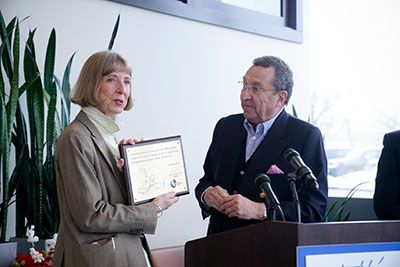
In November 1998, Roswell Park Comprehensive Cancer Center took a leap when it began to offer an emerging technology called Gamma Knife radiosurgery for many people with cancer and other disorders. Twenty years later, some 6,300 patients have been treated through this advanced and targeted approach — many of them from across the country and across the globe — and Roswell Park is an international leader and mentor in the most effective use of this advanced system.
Dan Leksell, MD, the son of the neurosurgeon who invented radiosurgery and developed the first Gamma Knife device, traveled to Buffalo today from his home in Sweden to mark the 20th anniversary of the Roswell Park Gamma Knife Program.
